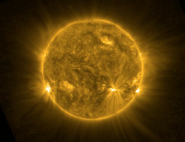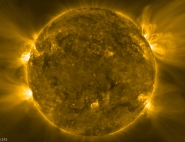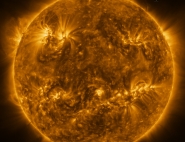STIX Instrument
The Spectrometer/Telescope for Imaging X-rays (STIX) provides imaging spectroscopy of solar thermal and non-thermal x-ray emission from ~4 to 150 keV. STIX will provide quantitative information on the timing, location, intensity, and spectra of accelerated electrons as well as of high temperature thermal plasmas, mostly associated with flares and/or microflares.
STIX is based on a Fourier-transform imaging technique essentially identical to that used successfully by the Hard X-ray Telescope (HXT) on the Japanese Yohkoh mission, and very similar to that used for RHESSI. As shown in the figure, the STIX instrument comprises three mechanically-decoupled modules:
- The Sun shades required by STIX play two roles. First, they are a prime element of the thermal control system, limiting the incident optical and infrared solar flux seen by the instrument. Second, they preferentially absorb the intense flux of low energy x-rays produced during large flares that would otherwise contribute to pulse pile-up and life time issues for the detectors. The top sunshade has a central 5 mm diameter circular opening (transmitting 0.54 W at 0.23 AU) for use by the STIX aspect system, and the bottom shade has a corresponding 35 mm diameter opening.
- The STIX imager uses a set of 64 subcollimators, each of which consists of a pair of widely separated grids. X-ray transmission through the grid pairs is a very sensitive function of the direction of incidence, so that the relative count rates of the detectors behind the different subcollimators encode the spatial information. This can be subsequently decoded on the ground to reconstruct images of the source region at different x-ray energies. The grid parameters are chosen to provide imaging information in the form of spatial Fourier components of the source (visibilities) in analogy with the imaging information provided by antenna pairs in a radio interferometer. The tungsten grids are fabricated with the same etch-and-stack process successfully used to make the finer RHESSI grids.
- The STIX Spectrometer uses 64 discrete Cadmium-Zinc-Telluride (CZT) planar detectors, one behind each subcollimator, to provide good energy resolution while operating at room temperature. CZT detectors have been flown in space, for example, on NASA's SWIFT mission where 32,768 such detectors have been used. A cold finger is required to maintain detectors and electronics at 25° C or less. Moveable attenuators enable STIX to be responsive to the entire expected intensity range of x-ray flux. Such attenuators, based on temperature sensitive shape memory alloy actuators, have proven to be effective and very reliable on RHESSI.
The telemetered STIX data correspond to the rates of individual detectors. Data selection, time and energy binning are done on board, so that a telemetry rate of 0.2 kbps can transmit an average of ~2000 images per hour for image reconstruction on the ground. A flare flag with source location can be made available on board in real time.


